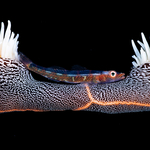With so many crab species in the ocean, it would be impossible to highlight them all. There are over 6,700 species of crabs identified as of today, in every ocean of the world. Here we’ve listed some of our favorites, plus a few of the most unusual.
The biggest (legged): Japanese spider crab
There is a debate as to whether this guy is the heaviest crab or not, but it definitely has the longest legs: these crabs can reach up to 12 feet (3.7 m) from claw to claw — that’s as long as a small car, to put things in perspective. The carapace itself is much smaller in comparison, measuring up to 16 inches (40 cm). These crabs are usually orange with white patches on the legs.
You’ll commonly find them in southern Japan, where they are fished for their meat. They also live in quite deep waters, up to 1,970 feet (600 m). They feed on dead animals as well as mollusks and plants. If they’re not fished out, Japanese spider crabs are also some of the longest living animals on the planet, reaching ages of up to 100 years.
The smallest: the pea crab
On the opposite end of the spectrum, meet the smallest crab in the world: the pea crab. As its name indicates, it is only a few millimeters long, about the size of a pea. Pea crabs are parasitic, meaning that they use other animals for survival, such as oysters or sea urchins, which provide they with safety, food and oxygen. This parasitic behavior makes mating inconvenient. Research shows that a male pea crab will rub the edge of whatever shell the female is inhabiting until it opens up and allows him to enter to mate. They feed on whatever their host ingests, as well as zooplankton and live wherever their hosts live, on the American Atlantic Coast and along the Pacific Coast.
The weirdest looking: the teddy bear crab
Possibly one of the strangest animals in the ocean, the teddy bear crab (also known as a hairy crab) is covered in what looks like fur. Short and bulky, it is really a strange sight. The crab’s strange attire is designed to help camouflage it from predators. You can find them in most tropical waters, mainly in the Red Sea, Indo-Pacific, Australia, and Japan, and they feed mainly on fish and sponges.
The strongest: the coconut crab
The coconut crab is also known as the robber crab or palm thief, which tells us a little bit about its habits. The coconut crab is a species of hermit crab that lives on land. It can grow up to 3.2 feet (1 m) long and weigh almost 9 pounds (4 kg).
Like other hermit crabs, coconut crabs use empty shells for protection, but only as juveniles. Later on, the adults grown their own exoskeleton. They feed primarily on fruits and nuts and are known to take anything left on the ground, hence their nickname of “robber crab.” They can crack coconuts open with their claws, which gives an idea of their power. Some research shows that their pinch may have more force than pretty much any animal bite on the planet but saltwater crocodiles. You can find them on islands across the Indian and Pacific Oceans.
The cutest: the pom-pom crab
This is of course debatable, but this crab is definitely one of the cutest in the ocean. Also known as the boxer crab, this little guy has a habit of carrying anemones in each claw that look like pom-poms or boxing gloves.
Why would they do this? By carrying a small anemone pretty much all the time, if attacked by a predator the pom-pom crab uses the poisonous anemone as a weapon. On top of that, the crab also uses the anemone’s tentacles to collect bits of food. (These little guys could also probably compete for “smartest” crab).
The pom-pom crab is small, about an inch long (2.5 cm), and has distinctive geometric markings on its carapace. There are actually a few different species that you can find mainly in the Indo-Pacific, Red Sea, and East African coast.
The post Crustacean Roundup: Top Five Crab Species appeared first on Scuba Diver Life.
Read MoreMarine SpeciesScuba Diver Life


